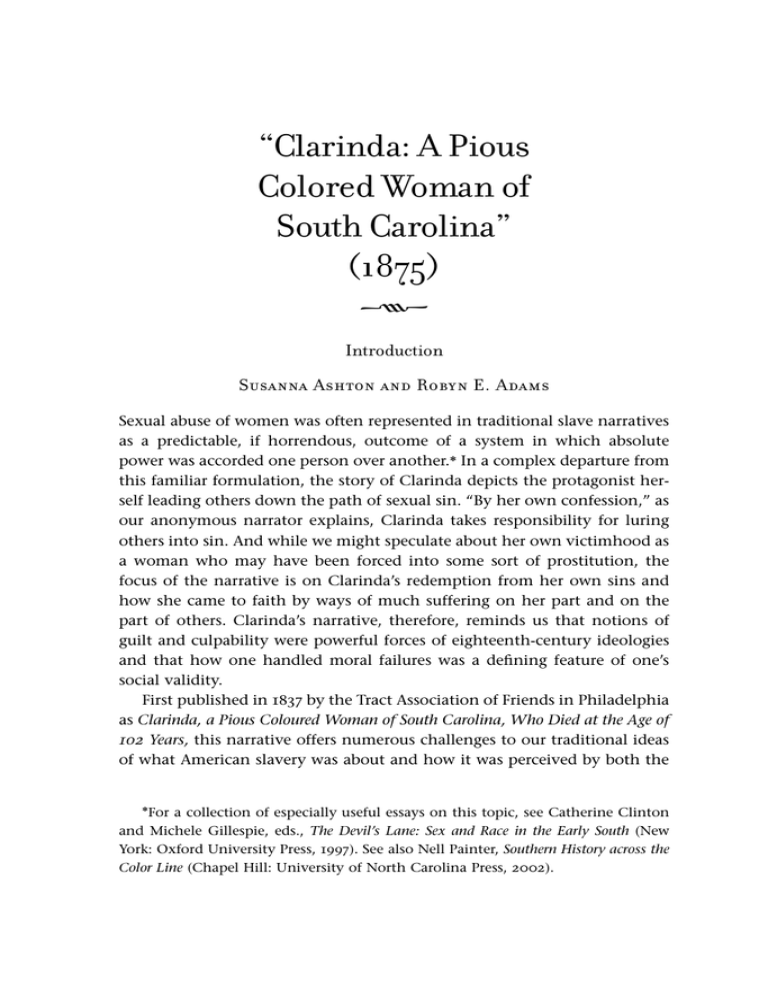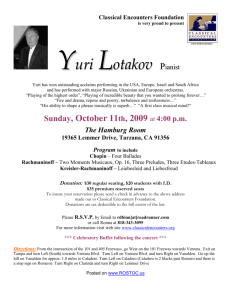k “Clarinda: A Pious Colored Woman of South Carolina”
advertisement

“Clarinda: A Pious Colored Woman of South Carolina” (1875) k Introduction Susanna Ashton and Robyn E. Adams Sexual abuse of women was often represented in traditional slave narratives as a predictable, if horrendous, outcome of a system in which absolute power was accorded one person over another.* In a complex departure from this familiar formulation, the story of Clarinda depicts the protagonist herself leading others down the path of sexual sin. “By her own confession,” as our anonymous narrator explains, Clarinda takes responsibility for luring others into sin. And while we might speculate about her own victimhood as a woman who may have been forced into some sort of prostitution, the focus of the narrative is on Clarinda’s redemption from her own sins and how she came to faith by ways of much suffering on her part and on the part of others. Clarinda’s narrative, therefore, reminds us that notions of guilt and culpability were powerful forces of eighteenth-century ideologies and that how one handled moral failures was a defining feature of one’s social validity. First published in 1837 by the Tract Association of Friends in Philadelphia as Clarinda, a Pious Coloured Woman of South Carolina, Who Died at the Age of 102 Years, this narrative offers numerous challenges to our traditional ideas of what American slavery was about and how it was perceived by both the *For a collection of especially useful essays on this topic, see Catherine Clinton and Michele Gillespie, eds., The Devil’s Lane: Sex and Race in the Early South (New York: Oxford University Press, 1997). See also Nell Painter, Southern History across the Color Line (Chapel Hill: University of North Carolina Press, 2002). “Clarinda: A Pious Colored Woman” | 41 white majority of the South and the abolitionists of the North. The nature of the second-person narration as presented here needs to be understood in the context of missionary tracts and Sunday school literature, early nineteenth-century notions of gender roles, and the often hazy line between free blacks and enslaved black people in South Carolina. While this extraordinary early account (the earliest known African American woman’s narrative from South Carolina) is a tricky text inasmuch as its provenance is complex and its focus on exemplary spiritual growth is at the expense of details about Clarinda’s almost certain bondage, the story of Clarinda nonetheless reaches across the centuries to remind us how historical realities rarely fit into preconceived textual forms. In the short twelve paragraphs that comprise the life story of Clarinda, she is introduced as a “corrupt heart . . . ‘sold under sin,’ and involved in almost every species of iniquity.” By playing the violin each Sunday and encouraging the mixing of the sexes through dance, she seems characterized as an antithesis to the model Christian as the instigator of moral and social sin. Even as Clarinda was beset with seizures and forced to forsake her music, she continued to model social “wickedness,” until the loss of her child caused her to sink into illness and despair. Inspired by spoken biblical scripture, Clarinda’s resulting conversion culminated with a divine charge to preach the Gospel, a mission fulfilled with weekly meetings in her home—notably attended by both black and white community members. Even after vicious attacks by angry neighbors that left her “head . . . deeply indented with the blows she received,” Clarinda persevered in her leadership of “Clarinda’s People,” ultimately learning to read before her death at the age of 102 years. As if to echo the relative silence of slave women within the greater slavenarrative genre, the most intriguing and problematic aspect of Clarinda is what we are not told about this remarkable life.* While there is a specific reference to her being “sold under sin,” Clarinda is never explicitly defined as a slave—a fact that opens up the possibility that she was part of the extremely small number of free blacks in South Carolina in the late eighteenth or early *Of the 296 slave narratives compiled by William L. Andrews on his authoritative “North American Slave Narratives” Web site, only 32 women, or a mere 10 percent, have biographies or autobiographies within the collection. If we examine this population more closely, fully two-thirds of these narratives were published postbellum. See William L. Andrews, “Introduction to the Scholarly Bibliography of Slave and Ex-Slave Narratives,” in “North American Slave Narratives” on the Web site titled Documenting the American South, University Libraries at the University of North Carolina at Chapel Hill, http://docsouth.unc.edu/neh/biblintro.html. 42 | I Belong to South Carolina nineteenth century. Far more likely, however, is that if she was a slave, that was not seen as a defining characteristic of her life by the narrator (if not by Clarinda herself). Rather, her status as a sinner outweighed any consideration of whether or not she was enslaved, at least as her story was framed by her narrator. Other details are also tellingly, if frustratingly, vague. No specific geographic references are given, nor are names of white families included that would aid in pinpointing Clarinda among the research of a specific region. Her occupation, for all the discussion of music and dancing, is never precisely articulated. The nature of her actions after being “sold under sin” seems to suggest forced prostitution, which may explain why the author readily notes that Clarinda was taught the violin for “the furtherance of her wicked designs.” In addition, the composition and fate of worshipers known as “Clarinda’s People” are undetermined and stand as an intriguing testament to the appeal of this religious leader. The most significant omission of all is the absence of her immediate voice. There are no known sources that contextualize the interview with Clarinda, and her story is told from afar. Our anonymous author may have known Clarinda, but at least one portion is from a thirdhand account. “The person who gives the account of Clarinda’s death” does give us some supposed dialogue from Clarinda, but the fact that much of this story seems to be from a viewpoint either once or twice removed forces us to question the validity of Clarinda’s “voice.” Yet while the biography of Clarinda focuses on her pious and humble nature, there was something compelling enough about Clarinda’s story that warranted her inclusion in a textbook for African American children in the 1830s. In the second edition of Biographical Sketches and Interesting Anecdotes of Persons of Color, edited by Abigail Mott in 1837, the story of “Clarinda” provides a female role model profiled alongside Phillis Wheatley and Benjamin Banneker.* Clarinda’s story dovetailed beautifully with the thesis of the 1837 collection: “to encourage virtue and morality in the different classes of society” by showing “the dreadful consequences of that arbitrary power invested in the slave-holder over his fellow being.” The target audiences of this textbook were the children at the New York African Free School (a large organization *The editor of this textbook, Abigail Mott (1766–1851), was an important Quaker antislavery activist and was also involved with the Underground Railroad in upstate New York. She was a cousin by marriage to the famous feminist and antislavery activist Lucretia Mott (1793–1880). “Clarinda: A Pious Colored Woman” | 43 founded in 1787 by the New York Manumission Society), who were evidently understood as needing role models in both spiritual and social terms.* At the end of the narrative about Clarinda a final clue about her legal status is revealed when, even after her heart was freed from the burden of sin, she remained subservient to some unnamed individual who limited the ways she could serve her God. Indeed, as Clarinda lay dying, “she requested that her people, as she called them, might continue to meet at her house; but this was not allowed” (emphasis added ). Just who was forbidding such meetings is not clear—it could have been another black or white religious leader of a more established church who denied Clarinda pastoral rights, but the emphasis on the house suggests that it was someone who controlled her space, possibly a landlord but most likely an owner who sought to regulate the activities of enslaved people under his control. On her deathbed she was nonetheless answerable to an earthly power. Of course, regardless of whether she was slave or free, her legacy was in the way she impacted the world in which she lived. “Clarinda’s People” continued to meet after her death; her story became a focus of the African Free School textbook, and her story resonates today as a vivid and rare tale of survival coming from the earliest known biography or autobiography of an African American woman in South Carolina. Rather than offering a host of problems, the text of Clarinda’s life introduces new dimensions to the canon of the slave experience. Reminding us that the line between free and enslaved black people was often hazy, the bondage experienced by Clarinda speaks to the opportunities and limitations imposed on all women as well as black people in eighteenth- and nineteenth-century South Carolina. Clarinda’s unadorned story also offers a glimpse into millions of slaves’ lives that lacked the drama of escape characterizing many of the narratives that made it to the abolitionist publishing houses. Stories such as Clarinda’s are nevertheless rich and powerful in their individual claims to the slaves’ own humanity. “Clarinda: A Pious Colored Woman of South Carolina” traces its start to 1836, where it may have appeared as tract 56 in a series issued by the Tract *A good historical and contextual overview of the New York African Free School may be found at the New-York Historical Society, which holds the papers from this organization. See the society’s Web site Examination Days: The African Free School Collection, https://www.nyhistory.org/web/afs. See also John L. Rury, “The New York African Free School, 1827–1836: Conflict over Community Control of Black Education,” Phylon 44, no. 3 (September 1983): 187–97. 44 | I Belong to South Carolina Association of Friends in Philadelphia after the last meeting of the year. Officially, tract 56 is listed in the April 12, 1837, annual report and could be found in print for many years afterward. Abigail Mott’s Biographical Sketches and Interesting Anecdotes of Persons of Color was first published in 1826 by both Mahlon Day Press and the firm of W. Alexander & Son in New York City, and it was intended for use in the African Free Schools of New York City. “Clarinda” was added to the second edition, published in 1837. This edition would be republished four times through 1854. In addition, Clarinda’s tract was published in the October 7, 1837, edition of the Quaker newspaper the Friend (Philadelphia). In 1875 and again in 1877, under the sponsorship of the estate of Lindley Murray, Mott would seek the assistance of fellow Quaker Mary Sutton Wood in a new version of her work titled Narratives of Colored Americans, which was published by William Wood & Co. of New York, owned by Mary Sutton’s husband. “Clarinda” appears in this text as well, although the content is targeted for a more general audience. This version of the text follows that of tract 56 and the version used in the 1837 second edition of Biographical Sketches. It contains additional text, beginning in paragraph three with “She was likewise reminded” and closing out the paragraph. There is no reasoning known for this material’s deletion in the 1875 edition. k The subject of this memoir was brought up in a state of ignorance unworthy of a Christian country, and following the propensities of a corrupt heart, was, by her own confession, “sold under sin,” and involved in almost every species of iniquity. For the furtherance of her wicked designs, she learned to play on the violin, and usually on the first day of the week sallied forth with her instrument, in order to draw persons of both sexes together, who, not having the fear of God before their eyes, delighted like herself, in sinful and pernicious amusements, which keep the soul from God, and the heart from repentance. But even on these occasions she found it difficult to struggle against the Spirit of the Most High. Often was it sounded in her conscious, “Clarinda, God ought not to be slighted” “God ought not to be forgotten”: but these monitions were treated with derision, and in the hardness of her heart would exclaim, “Go, you fool, I do not know God—Go, I do not wish to know him.” On one occasion, whilst on her way to a dance, these blasphemous thoughts, in answer to the monitions of conscience, were passing through her mind, and in this frame she reached the place of appointment, and mingled in “Clarinda: A Pious Colored Woman” | 45 the gay throng. Whilst participating in the dance, she was seized with fits, and convulsively fell to the ground. From that moment she lost her love of dancing, and no more engaged in this vain amusement. She did not, however, forsake the evil of her ways, but continued her course of wickedness. Thus she went on for about twenty years, when she lost her only child, and was confined for several months by severe illness. During this period of bodily suffering, her mind was brought under awful convictions for sin: she perceived that the Great Jehovah was a sinhating and a sin-avenging God, and that he will by no means clear the guilty. She remained in a distressed state of mind for about three months, and when a little bodily strength was restored, she sought solitary places, where she poured out her soul unto the Lord, and in his own good time He spoke peace to her wounded spirit. One day, being thus engaged in earnest prayer, and looking unto the Lord for deliverance, the evening approached unregarded, her soul was deeply humbled, and the night passed in prayer, whilst rivers of tears (to use her own expressive language) ran down her cheeks, and she ceased not to implore mercy from Him who is able to bind up the broken-hearted. While thus engaged, and all this time ignorant of her Savior, something whispered to her mind, “Ask in the name of Christ.” She queried, “Who is Christ?” and in reply, these passages of Scripture seemed repeated to her, “Let not your heart be troubled; ye believe in God, believe also in Me.” “In My Father’s house are many mansions: I go to prepare a place for you, that where I am there ye may be also.” “I am the way, the truth, and the life; no man cometh unto the Father but by Me.” Being desirous to know whence these impressions proceeded, she was made to believe that they were received through the influence of the Holy Spirit. This remarkable passage was also presented to her mind: “Therefore, being justified by faith, we have peace with God through our Lord and Savior Jesus Christ.” She was likewise reminded of several dreams she had formerly had; in one of which a person appeared to her and led her to a place into which she was permitted to look, where she saw “the spirits of just men made perfect,” but was informed she could not enter therein. He then gave her a vial and a candle, telling her to keep the vial clean, and the candle burning till He came. She now saw that the vial was her heart, and the candle the Spirit of the Lord. In narrating this circumstance to a friend, she enlarged instructively on the necessity of keeping the heart, since out of it are the issues of life; adding, the eye sees and the heart lusts after the pleasures and possessions of this world, but the crosses of self-denial must be borne; no outside religion will do. She now felt the love of God shed abroad in her heart; the overwhelming 46 | I Belong to South Carolina burden of sin was removed, and she received ability to sing the praises to the Lord on the banks of deliverance. Having been thus permitted to see the desire of her soul, she was anxious to learn more of the divine will, and inquired, like the apostle, “Lord, what wilt thou have me to do?” and like him she was commanded to be a witness of what she had seen and heard. Believing she had a commission given her to preach the Gospel, she began to warn the sinful and licentious, that they must crucify the man of sin, or forever forego the hope of salvation. This raised her a host of enemies, both white and colored; she underwent for many years cruelty and persecution which could hardly obtain credence. She bore about on her body the visible marks of her faithful allegiance to the Lord Jesus; yet, while alluding to this, tears filled her eyes, and she said with emotion, “I am thankful that I have been found worthy to suffer for my blessed Savior.” Although living in great poverty, and subsisting at times on casual charity, with health impaired by the sufferings through which she had passed, yet neither promises of protection, accompanied with the offer of the good things of this life, on the one hand, nor the dreadful persecution she endured on the other, could make her relinquish the office of a minister of the Gospel. This office she continued to exercise, holding meetings regularly on the first day of the week, at her own little habitation, where a greater number at times assembled than could be accommodated in the house. It may be interesting to add some particulars relative to the trial of her faith and the persecution she suffered. One individual in whose neighborhood she lived, who was much annoyed by hearing her sing and pray, offered, if she would desist, to provide her with a home and the comforts of life; but she replied, she had received a commission to preach the Gospel, and she would preach it as long as she had breath. Several ill-intentioned persons one night surrounded her house, and commanded her to come out to them. This she refused to do. After threatening her for some time, they forced open the door, and having seized their victim, they beat her cruelly, so that her head was deeply indented with the blows she received. At another time she was so much injured that she was left nearly lifeless on the open read, whither she had fled to escape from them; but her unsuccessful efforts increased the rage of her pursuers, and after treating her with the utmost barbarity, they left her. She was found after some time, but so exhausted by the loss of blood, that she was unable to walk, and from the effects of the cruelty she did not recover for years. But it may be said of her, that she joyfully bore persecution for Christ’s sake. “Clarinda: A Pious Colored Woman” | 47 A man who lived in the same village, being much incensed at the undaunted manner in which she stood forth as the minister of the meek and crucified Savior, swore that he would beat her severely if ever he found an opportunity. One evening, as she was walking home on a solitary road, she saw this person riding towards her; she knew of his intentions, and from his character did not doubt that he would execute them. She trembled from head to foot; escape seemed impracticable, and prayer was her only refuge. As he advanced she observed that his handkerchief fell and was wafted by the wind to a little distance; she picked it up—he stopped his horse, and she handed it to him in a submissive manner; he looked at her fiercely for a moment, when his countenance softened; he took it, saying, “Well, Clarinda,” and passed on. She was not able to read a word till her 66th year, but was in the practice of getting persons to read the Holy Scriptures to her; much of which she retained in her memory with remarkable accuracy. By dint of application, she was at length able to read them herself; and those who visited her in advanced life, found her knowledge of the Scriptures, as well as her growth in grace, very surprising. When she was one hundred years old, and very feeble, she would, if able to get out of bed, on the morning of the first day of the week, discharge what she thought to be her duty, by conversing with and exhorting both the white and colored people who came to her house, often standing for half an hour at a time. Her zeal was indeed great, and her faith steadfast. She said she often wished she could write, that she might in this way also express her anxiety for the good of souls. Then she would have described more of the exercises of her mind upon the depravity of man by nature and by practice, with the unbounded and redeeming love and mercy of God through Jesus Christ. The person who gives the account of Clarinda’s death says, “I was prevented seeing her often in her last moments; when I did she was always the same: her one theme the love of God to poor sinners, which was always her style of speaking. One day, as I sat by her bedside, she said to me, ‘Do you think I am a Christian?’ ‘Yes,’ I answered, ‘I do believe you are a Christian.’ ‘I have tried to be,’ she replied, ‘but now that I suffer in my body, when I think what an unprofitable servant I have been, I am distressed.’ She then wept. ‘You know,’ I said, ‘it is not how much we can do, but what we do sincerely for the love of Christ, that is acceptable.’ She seemed comforted, and talked as usual. “She showed me much affection when I left her, saying ‘I shall not live long, my dear—,’ and adding a few other words, blessed me, and bid me 48 | I Belong to South Carolina pray for her. She had frequently expressed her fears of the bodily sufferings of death, but not accompanied with a dread of eternal death. I asked her when she was ill, if she now feared to die. She said ‘No: this fear was taken away some time previous to my illness.’” She requested that her people, as she called them, might continue to meet at her house; but this was not allowed. I am told they meet sometimes elsewhere, and are called “Clarinda’s People.” When dying, she told those near her, to follow her only as she had followed Christ. Her death occurred in 1832. “Those that be planted in the house of the Lord shall flourish in the courts of our God. They shall bring forth fruit in old age.” While perusing this remarkable account of “a brand plucked from the burning,” let those who from their earliest years have enjoyed the inestimable privilege of access to the Sacred Volume, and various other religious means, seriously consider the blessed Savior’s words—“To whom much is given, of him much shall be required.”





